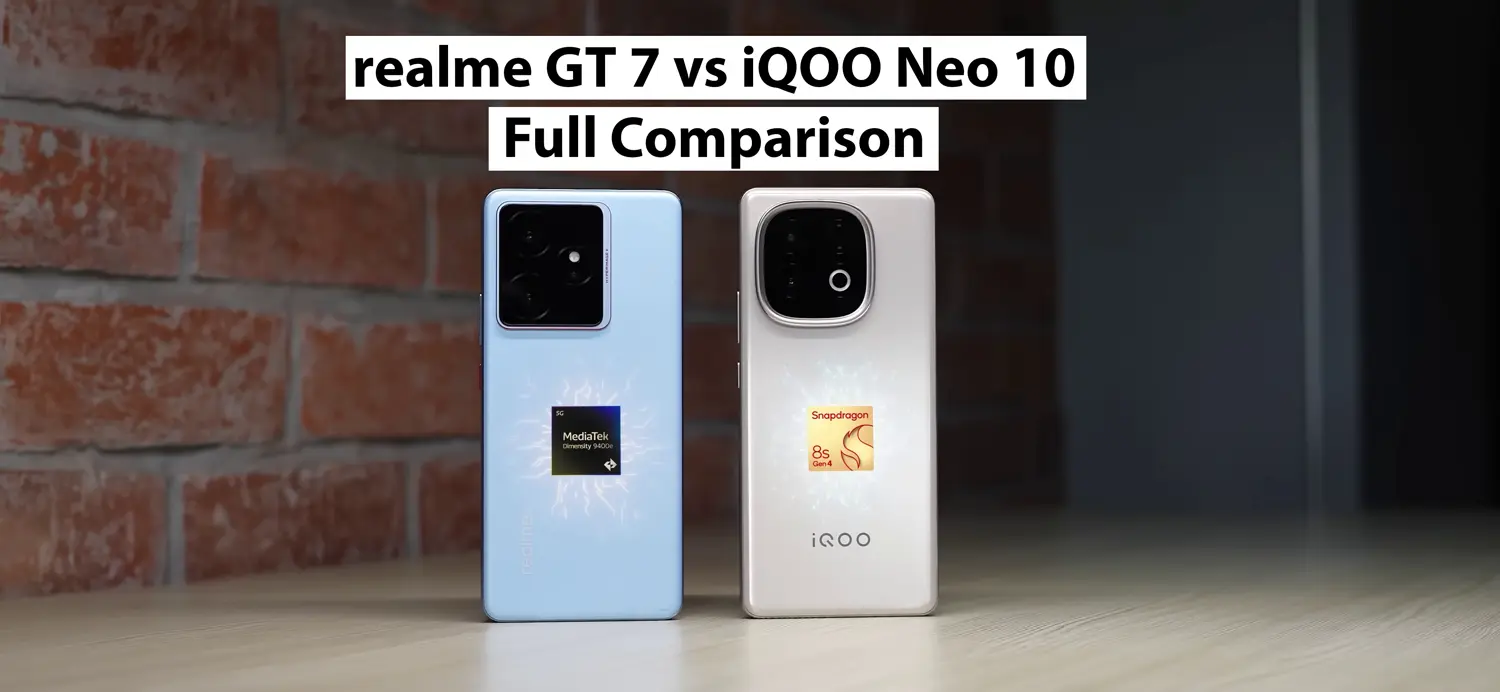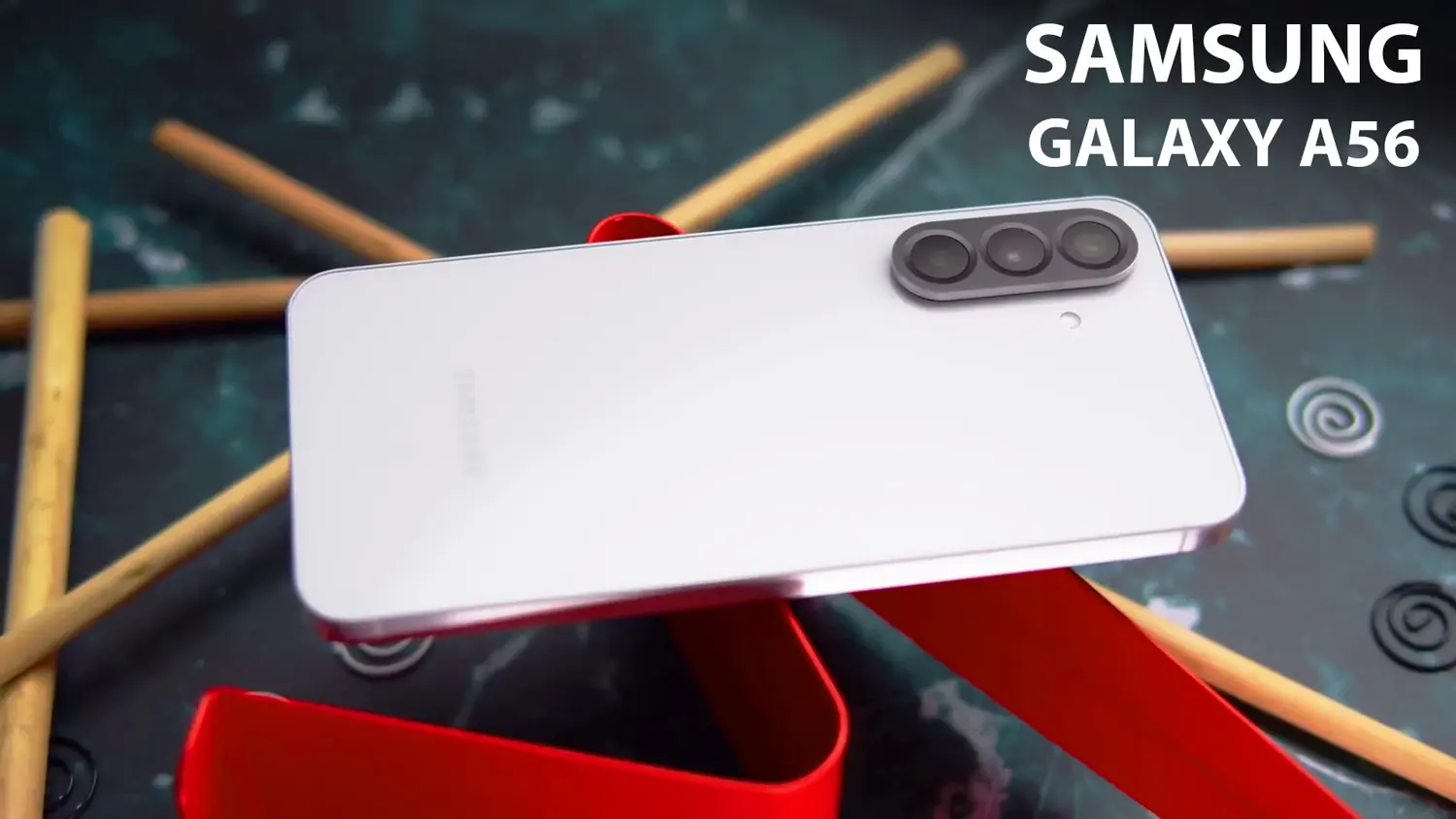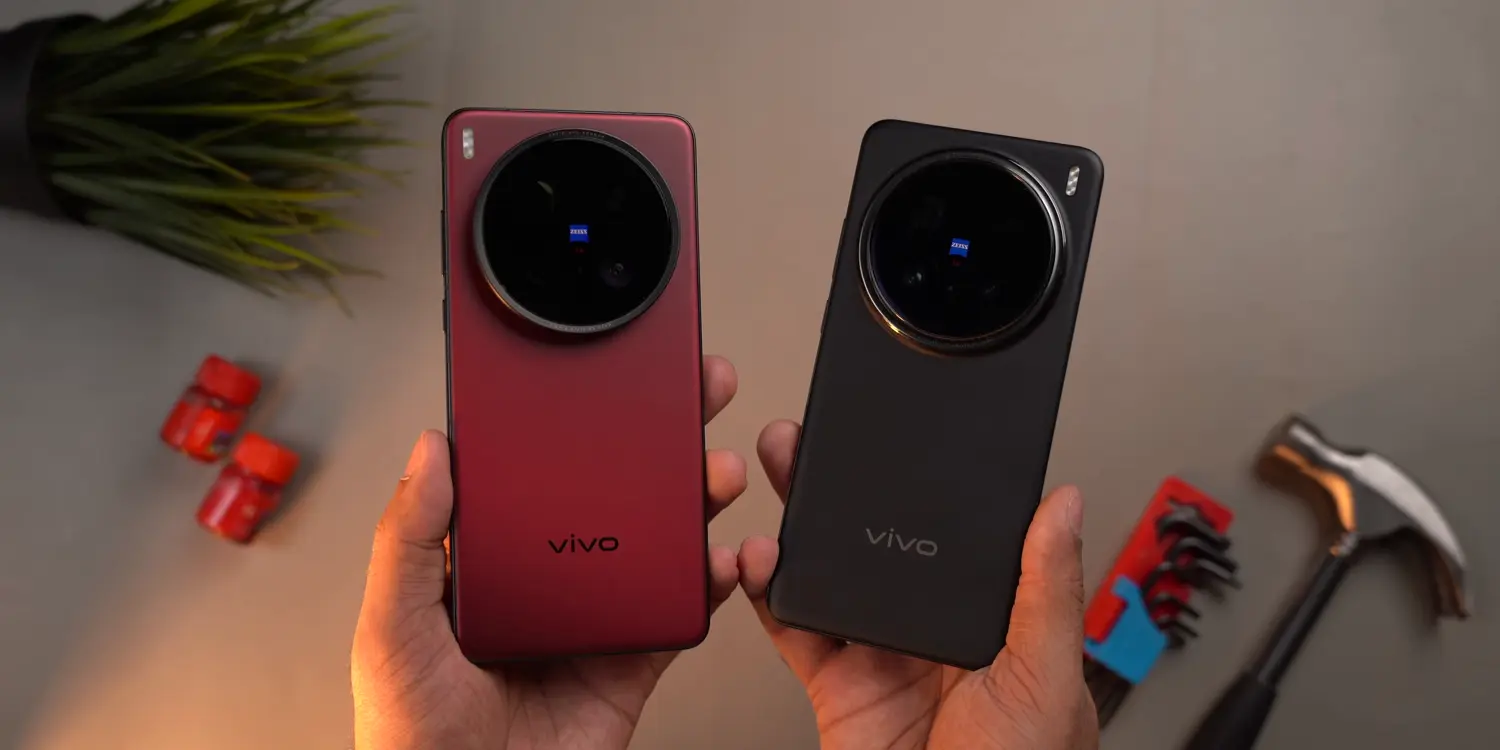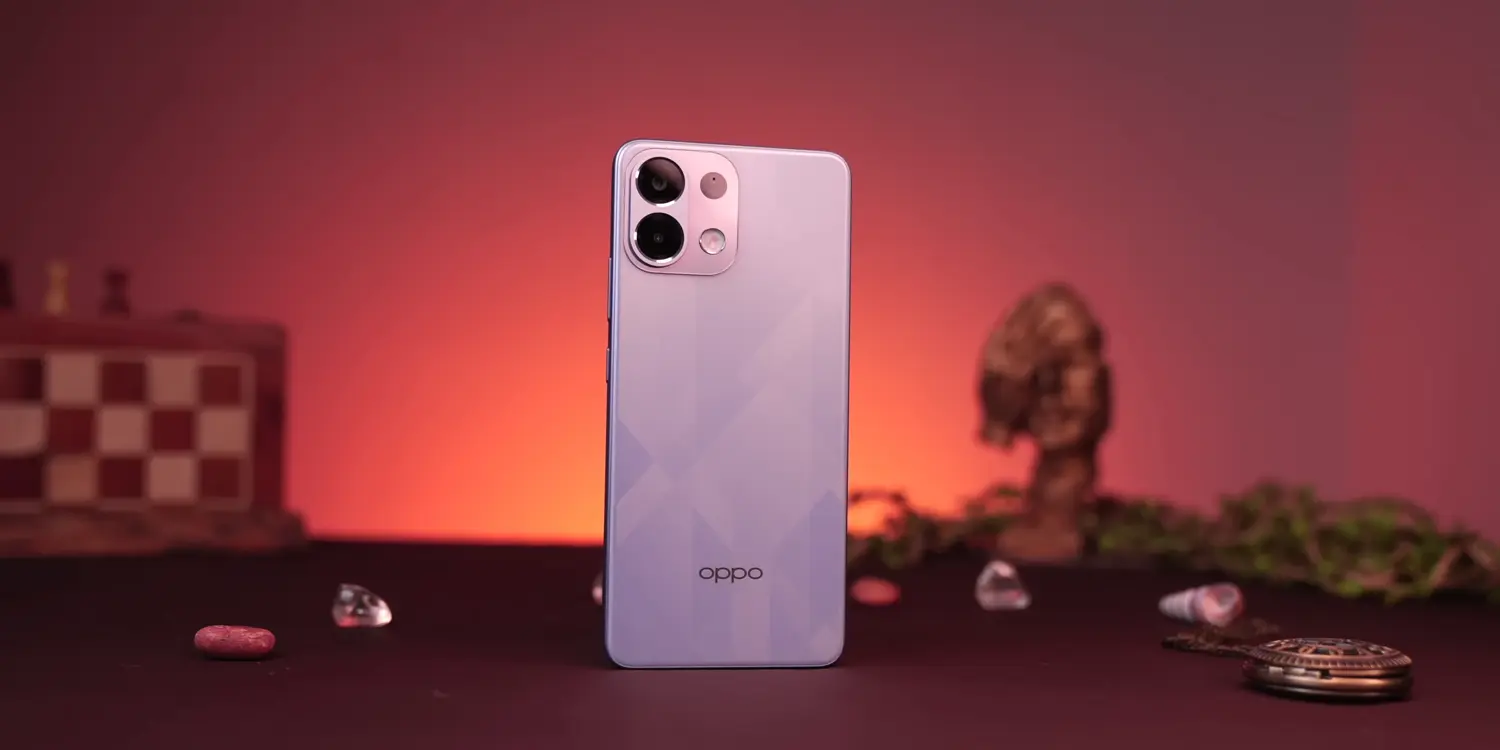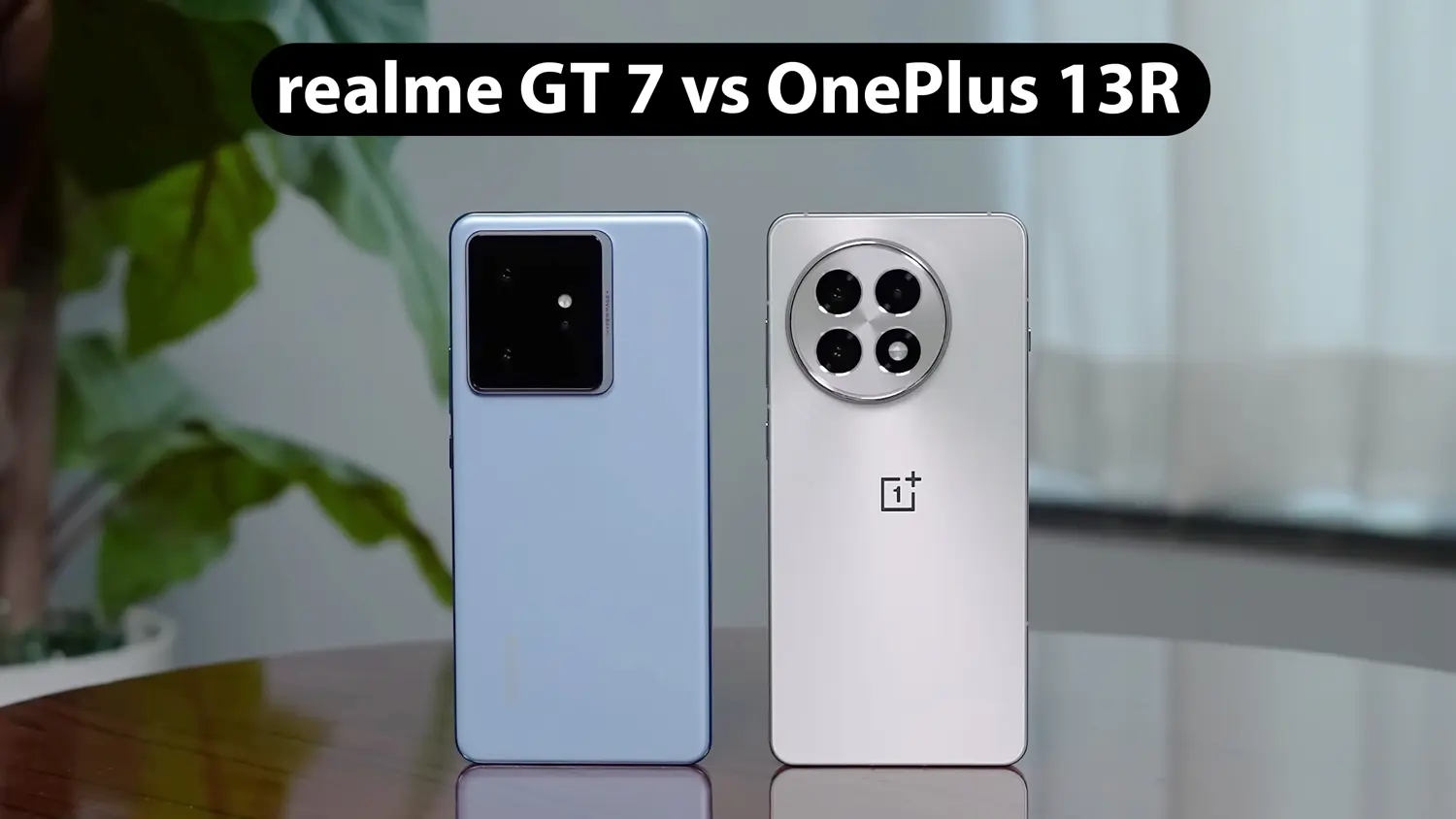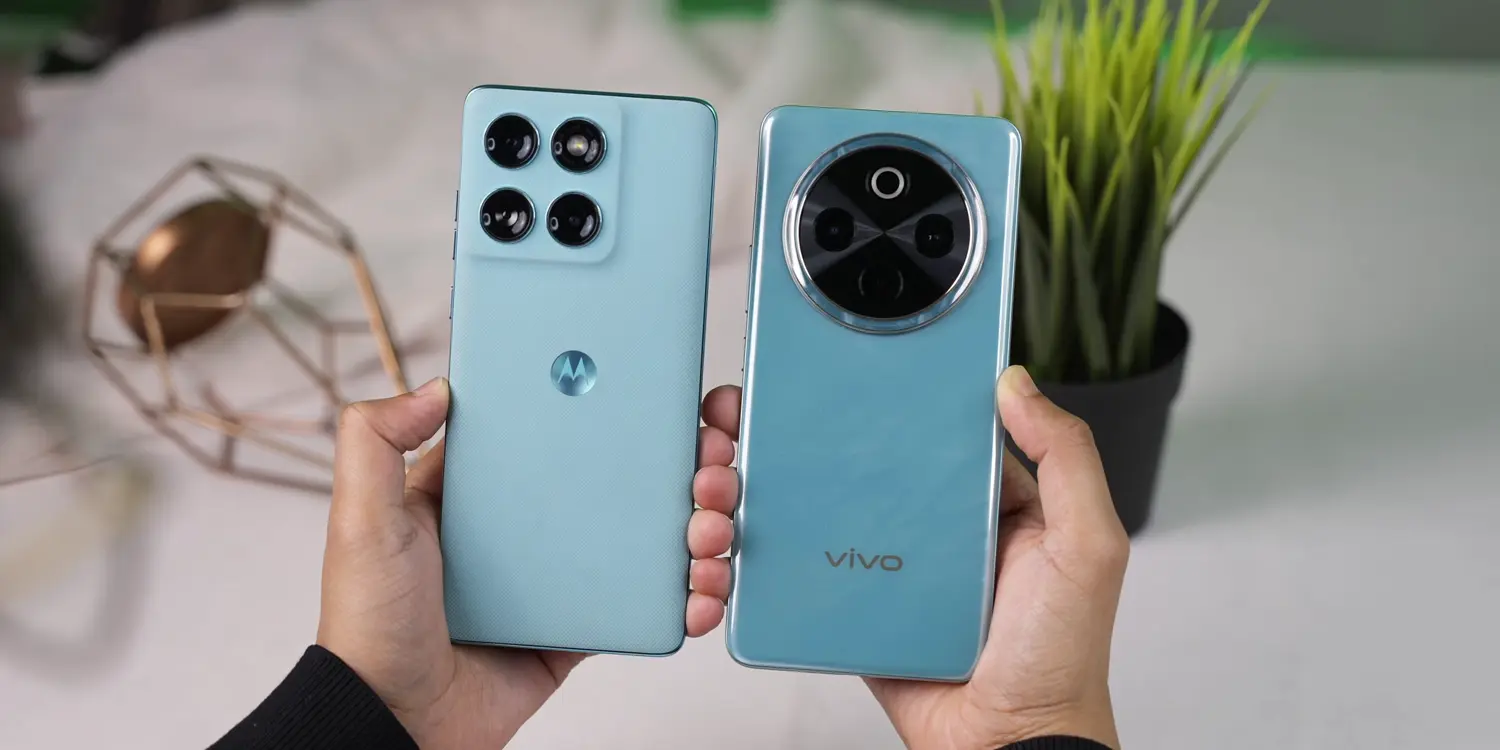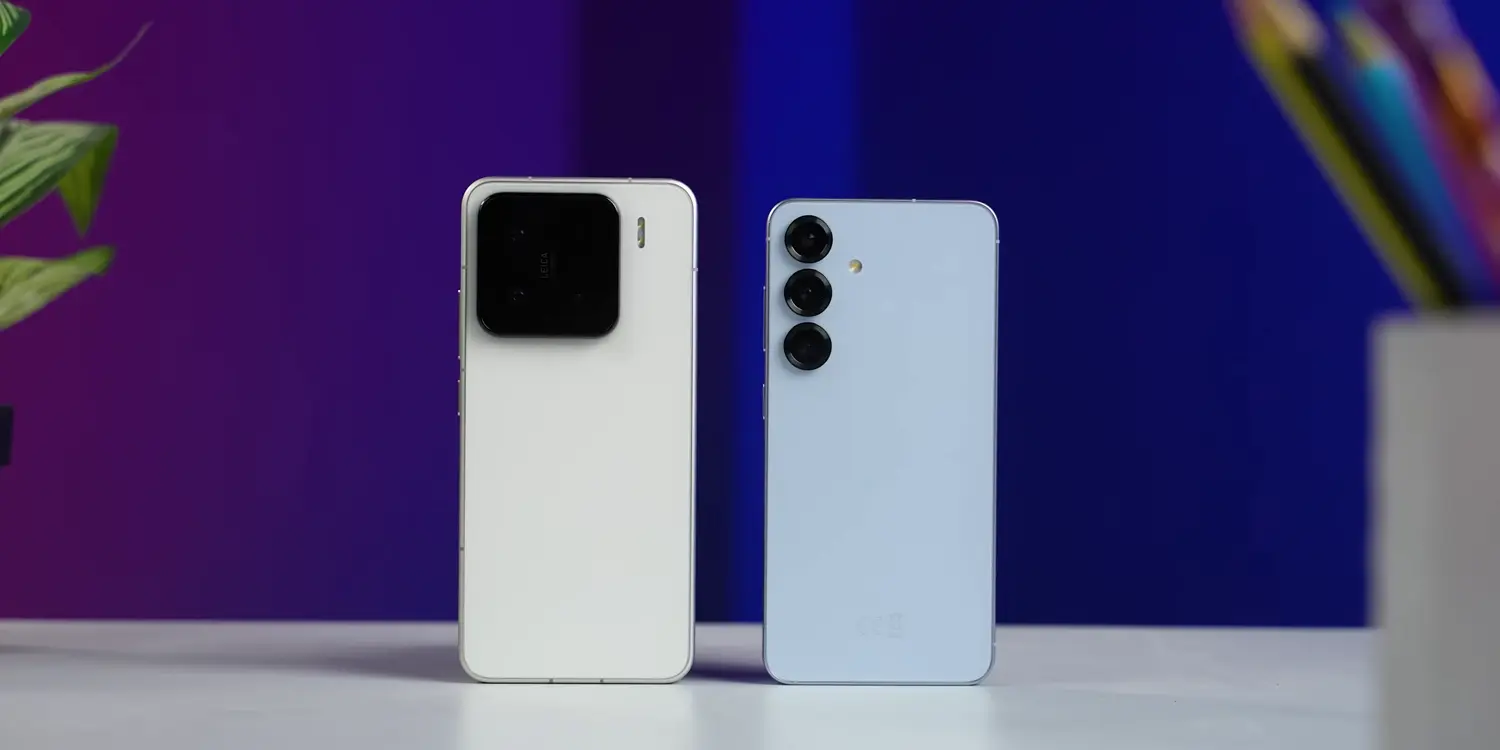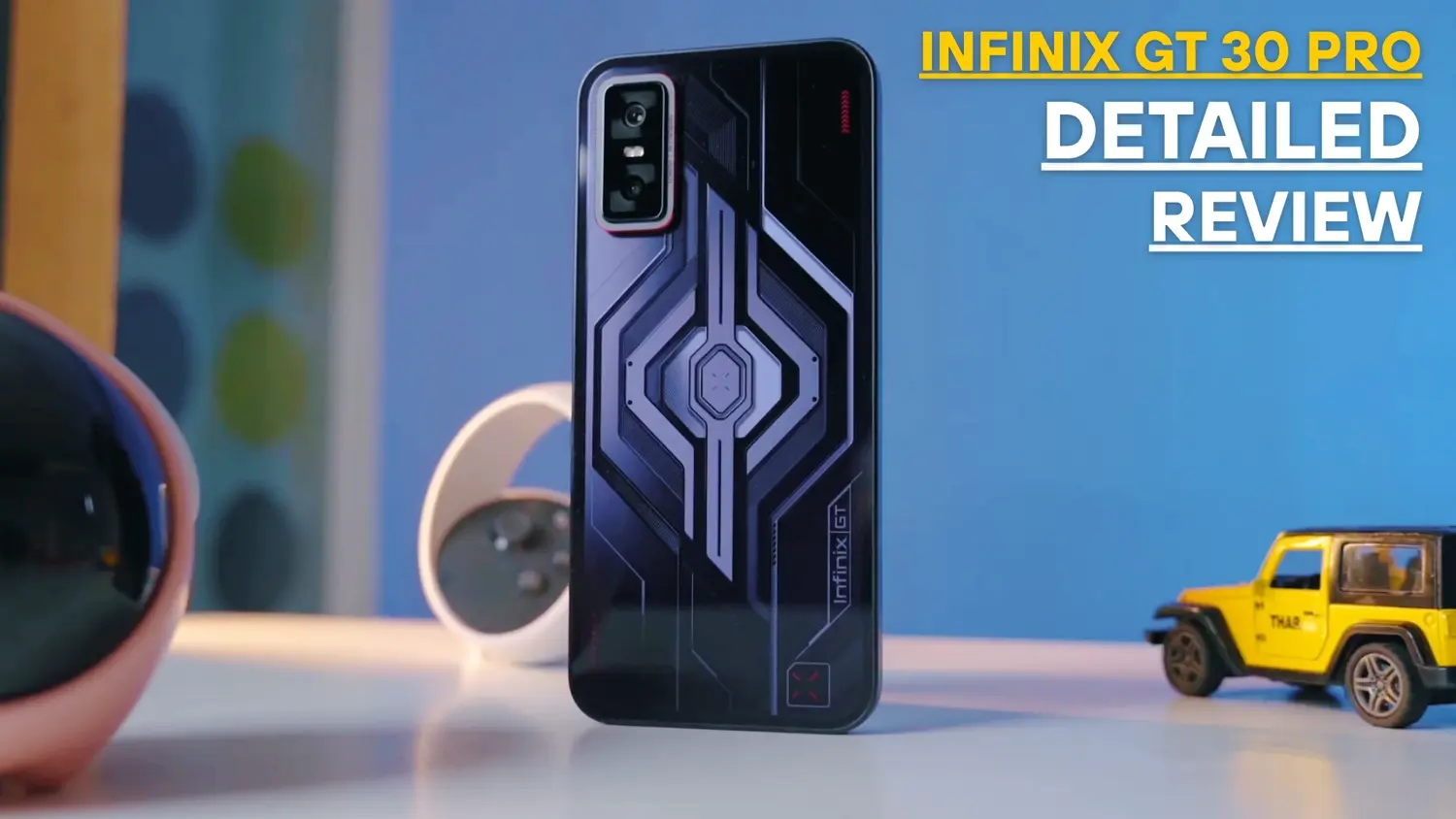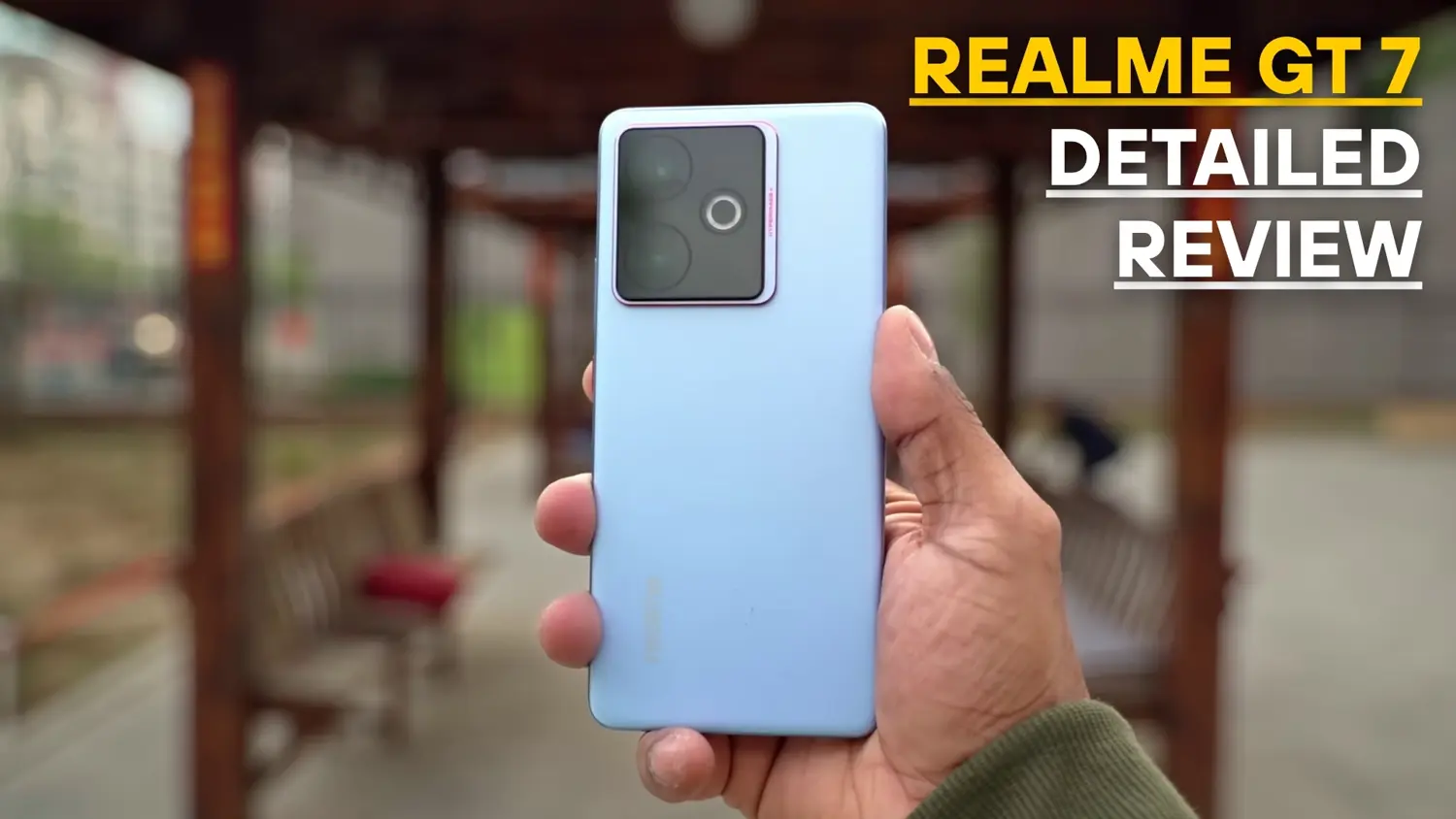In the ever-evolving smartphone market, the battle for supremacy in the mid-range segment is fiercer than ever. Two devices that have captured significant attention in 2025 are the Realme GT 7 and the iQOO Neo 10. Powered by the MediaTek Dimensity 9400e and Qualcomm Snapdragon 8s Gen 4, respectively, these phones promise flagship-level performance at competitive prices. With similar designs, massive batteries, and robust feature sets, choosing between them can be challenging. This detailed comparison dives into every aspect—design, display, performance, cameras, battery, software, and more—to help you decide which phone offers the best value for your needs.
Specifications at a Glance
Below is a side-by-side comparison of the key specifications for the Realme GT 7 and iQOO Neo 10:
| Feature | Realme GT 7 | iQOO Neo 10 |
|---|---|---|
| Processor | MediaTek Dimensity 9400e | Qualcomm Snapdragon 8s Gen 4 |
| RAM Options | 8GB, 12GB (LPDDR5X) | 8GB, 12GB, 16GB (LPDDR5X Ultra) |
| Storage Options | 256GB, 512GB (UFS 4.0) | 128GB, 256GB, 512GB (UFS 4.1) |
| Display | 6.78-inch AMOLED, 1.5K (1264×2780), 120Hz, LTPO | 6.78-inch AMOLED, 1.5K (1264×2780), 144Hz |
| Peak Brightness | 6,000 nits (claimed), 1,600 nits HBM | 4,400 nits (claimed), 2,000 nits HBM |
| Display Protection | Gorilla Glass 7i | Schott Xensation UP |
| Rear Cameras | 50MP (main, Sony IMX906, OIS) + 50MP (2x telephoto) + 8MP (ultra-wide) | 50MP (main, OIS) + 8MP (ultra-wide) |
| Front Camera | 32MP | 32MP |
| Video Recording | 8K@30fps, 4K@120fps, Dolby Vision | 4K@60fps |
| Battery | 7,000mAh, 120W fast charging | 7,000mAh, 120W fast charging |
| Operating System | Realme UI 6.0 (Android 15) | Funtouch OS 15 (Android 15) |
| Software Updates | 4 years OS, 6 years security | 3 years OS, 4 years security |
| Build | Plastic frame, IP69 rating | Plastic frame, IP65 rating |
| Weight | 206g | 206g |
| Thickness | 8.3mm | 8.1mm |
| Connectivity | 5G, Wi-Fi 7, Bluetooth 5.4, NFC, USB 2.0 | 5G, Wi-Fi 7, Bluetooth 5.4, NFC, USB 2.0 |
| Additional Features | Infrared blaster, graphene cooling, AI Planner | Infrared blaster, Q1 graphics chip |
| Price (Starting) | ₹39,999 (8GB/256GB) | ₹31,999 (8GB/128GB) |
Design and Build Quality
Both the Realme GT 7 and iQOO Neo 10 adopt a modern, premium aesthetic that mirrors their flagship counterparts, the Realme GT 7 Pro and iQOO 13, respectively. Their camera modules are a key design cue, with the GT 7 featuring an accented camera island and a colored power button for a touch of flair. The iQOO Neo 10, on the other hand, opts for a cleaner, more minimalist look. Both phones are available in muted color options, though the iQOO Neo 10’s Inferno Red variant appeals to those who prefer bolder hues.
Weighing 206 grams each, the phones feel similar in hand, but the iQOO Neo 10 is slightly slimmer at 8.1mm compared to the GT 7’s 8.3mm. The Neo 10’s slightly curved back panel enhances grip, making it more comfortable for prolonged use, despite a bottom-heavy weight distribution. The Realme GT 7, with its blockier design, feels less ergonomic but compensates with subtle design accents. Both phones use plastic frames to accommodate their massive 7,000mAh batteries, a practical choice to keep weight in check.
In terms of durability, the Realme GT 7 has an edge with its IP69 rating, offering superior dust and water resistance compared to the iQOO Neo 10’s IP65 rating. The GT 7’s Gorilla Glass 7i provides decent scratch protection, while the Neo 10 uses Schott Xensation UP glass, both ensuring robust display protection. Additionally, both phones include an infrared blaster, though its placement differs: top-mounted on the GT 7 for intuitive use and within the camera module on the Neo 10.
Verdict: The Realme GT 7 offers a slightly more premium and durable build, while the iQOO Neo 10 prioritizes ergonomic comfort.
Display
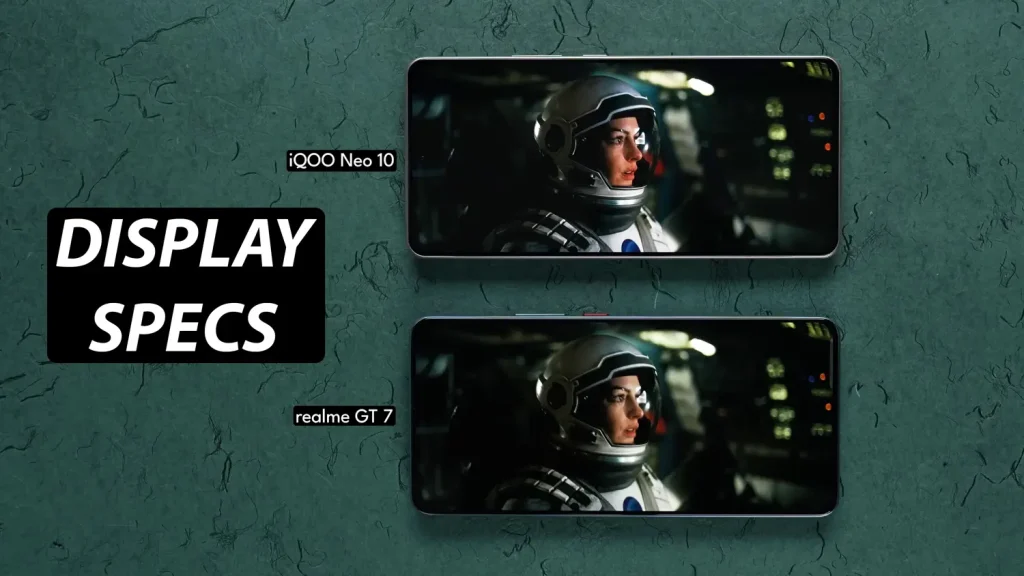
Both smartphones feature a 6.78-inch AMOLED display with a 1.5K resolution (1264×2780), delivering vibrant colors and sharp visuals. The Realme GT 7 uses an LTPO panel with an adaptive 120Hz refresh rate, while the iQOO Neo 10 supports up to 144Hz, though the higher refresh rate is limited to specific gaming scenarios. Both displays offer variable refresh rates (60Hz, 90Hz, 120Hz) to optimize battery life based on content.
Brightness is a key differentiator. The iQOO Neo 10 claims a peak brightness of 4,400 nits (2,000 nits in High Brightness Mode), outperforming the Realme GT 7’s 6,000 nits claim (1,600 nits HBM) in real-world scenarios, especially outdoors. The Neo 10 also excels in HDR content playback, with HDR10+ support, while the GT 7 supports Dolby Vision, making it a better choice for streaming services like Netflix.
Color accuracy leans slightly in favor of the iQOO Neo 10, with its Original Procolor mode delivering near-neutral tones compared to the GT 7’s slightly saturated output. Both phones feature 10-bit panels and high PWM dimming (4,320Hz on Neo 10, 2,160Hz on GT 7) to reduce flicker in low light. Haptic feedback is superior on the GT 7, thanks to its O-Haptics motor, offering more precise vibrations.
Verdict: The iQOO Neo 10’s brighter display and higher refresh rate make it ideal for gaming and outdoor use, while the GT 7’s Dolby Vision and superior haptics enhance multimedia experiences. Want something sleeker? Here’s our Samsung Galaxy S25 Edge review.
Performance
Performance is where these phones shine, powered by cutting-edge chipsets. The Realme GT 7 houses the MediaTek Dimensity 9400e, while the iQOO Neo 10 features the Qualcomm Snapdragon 8s Gen 4. Both are paired with LPDDR5X RAM (up to 12GB for GT 7, 16GB for Neo 10) and fast storage (UFS 4.0 for GT 7, UFS 4.1 for Neo 10).
In benchmarks, the GT 7 takes a slight lead, scoring higher on AnTuTu (around 2 million vs. Neo 10’s 1.9 million) and Geekbench, with a stronger GPU performance in 3DMark Wild Life Extreme (60% better). However, the iQOO Neo 10’s Snapdragon chip, paired with a dedicated Q1 graphics chip, offers higher throughput for short gaming sessions, making it ideal for burst performance. The GT 7, with its graphene cooling layer and 7K vapor chamber, maintains better thermal stability, running cooler during extended gaming (e.g., emulation or heavy titles).
Both phones deliver smooth multitasking and support 120fps in games like BGMI and Call of Duty: Mobile, with thermals leveling off at around 38°C after 30-minute sessions. The Neo 10 initially showed thermal throttling in stress tests, but recent updates have improved its stability.
Verdict: The Realme GT 7 is better for sustained gaming due to its superior cooling and GPU stability, while the iQOO Neo 10 excels in raw performance for shorter sessions. If raw power is your thing, don’t miss our in-depth Vivo X200 Ultra flagship review.
Camera
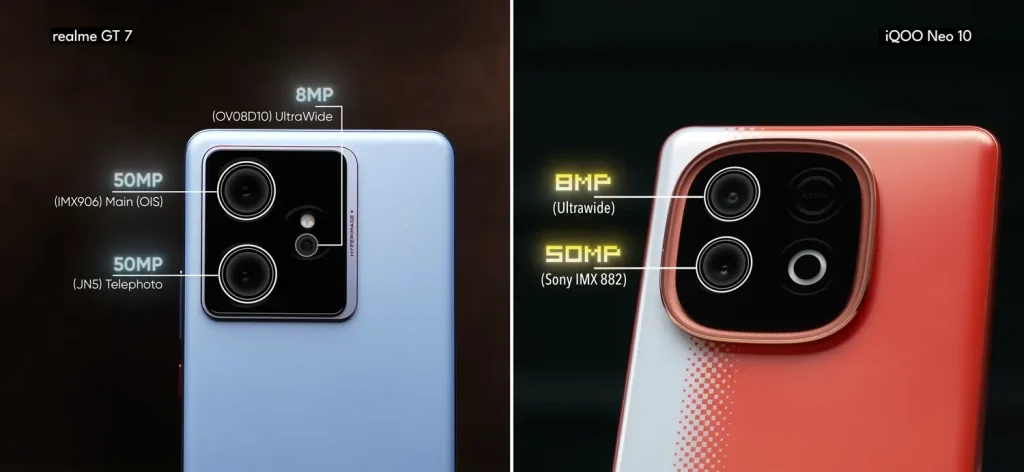
The Realme GT 7 boasts a versatile triple-camera setup: a 50MP Sony IMX906 main sensor with OIS, a 50MP 2x telephoto lens, and an 8MP ultra-wide. The iQOO Neo 10, in contrast, features a dual-camera system: a 50MP main sensor with OIS and an 8MP ultra-wide, with both phones sporting a 32MP selfie camera.
In daylight, the Neo 10’s main camera produces vibrant, well-balanced images with superior HDR tuning, avoiding the oversharpening issues seen in the GT 7. However, the GT 7’s telephoto lens offers better zoom performance (2x, 3x, 5x, and 10x), capturing more detail in both daylight and low light. The Neo 10 slightly outperforms in low-light photography with its AI upscaling, delivering brighter and better-managed shots.
For portraits, the GT 7’s telephoto lens provides natural bokeh and better edge detection, while the Neo 10’s portraits are brighter but show slight skin smoothening. The ultra-wide cameras on both are average, with the Neo 10 edging out slightly due to less oversharpening. Selfie performance tilts toward the GT 7, with more detailed and neutral-toned shots, especially in video (4K@60fps).
The GT 7’s videography capabilities are superior, supporting 8K@30fps, 4K@120fps, and Dolby Vision, compared to the Neo 10’s 4K@60fps. However, in 4K@60fps tests, the Neo 10 occasionally retrieves better details. The ultra-wide cameras on both are limited to 1080p@30fps and perform poorly in low light.
Verdict: The Realme GT 7 is the better choice for photography and videography due to its telephoto lens and advanced video features, despite some oversharpening issues.
Battery and Charging
Both phones pack massive 7,000mAh batteries with 120W fast charging, delivering exceptional endurance. In real-world tests, the iQOO Neo 10 offers slightly better battery life, providing about 30 minutes more screen-on time than the GT 7, with both lasting up to two days on moderate use. The Neo 10 charges from 0-100% in 40 minutes, while the GT 7 takes 42 minutes, with the Neo 10’s GaN charger also capable of charging devices like a MacBook.
Verdict: The iQOO Neo 10 has a slight edge in battery life and charger versatility, but both phones excel in this category.
Software
The Realme GT 7 runs Realme UI 6.0 based on Android 15, offering 4 years of OS updates and 6 years of security patches. The iQOO Neo 10 runs Funtouch OS 15, also based on Android 15, with 3 years of OS updates and 4 years of security patches. Realme UI 6.0 feels smoother, with modern features like AI Planner, Live Activities, and Flux Themes, alongside Gemini integration and Circle to Search. Funtouch OS 15, while functional, has more bloatware and less refined animations.
Verdict: Realme GT 7 provides a superior software experience with longer update support and more advanced features.
Network and Connectivity
Both phones offer robust connectivity, including 5G, Wi-Fi 7, Bluetooth 5.4, NFC, and an infrared blaster. Network performance is reliable, even on challenging networks like Jio in India. However, both use USB 2.0 ports, which is disappointing for gaming-oriented phones that could benefit from faster data transfer and display output via USB 3.1.
Verdict: No significant differences in connectivity, but the USB 2.0 port is a missed opportunity for both.
Pricing and Value
The Realme GT 7 starts at ₹39,999 (8GB/256GB), while the iQOO Neo 10 is more affordable at ₹31,999 (8GB/128GB), with a 12GB/256GB variant at ₹35,999. The price gap of approximately ₹3,000–₹5,000 after discounts makes the Neo 10 a compelling value proposition, offering comparable performance, a brighter display, and slightly better battery life. However, the GT 7 justifies its premium with better cameras, software, and build quality.
Verdict: The iQOO Neo 10 offers better value for budget-conscious buyers, while the Realme GT 7 appeals to those prioritizing cameras and software. Still confused? You might also want to check out our Samsung Galaxy F56 and Oppo K13 reviews.
Conclusion
The Realme GT 7 and iQOO Neo 10 are formidable contenders in the mid-range segment, each excelling in different areas. The GT 7 stands out with its superior camera versatility, sustained gaming performance, premium build (IP69), and refined software experience. The iQOO Neo 10, however, offers a brighter display, slightly better battery life, and raw performance at a lower price, making it a fantastic value option.
Choose the Realme GT 7 if you prioritize photography, videography, sustained gaming, and a modern software experience with longer update support.
Choose the iQOO Neo 10 if you want a brighter display, better value, and high performance for shorter gaming sessions.
As prices fluctuate, the Realme GT 7 could become even more competitive if discounts bring it closer to the Neo 10’s price range. Ultimately, your choice depends on whether you value camera and software refinement or raw performance and affordability.
